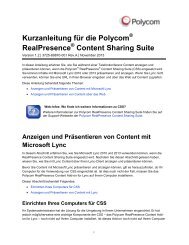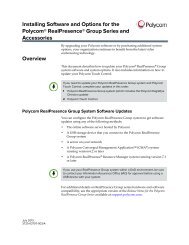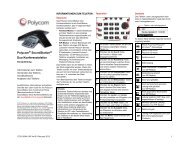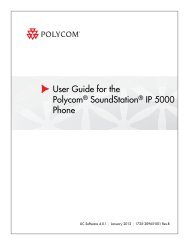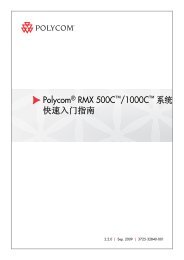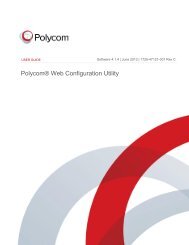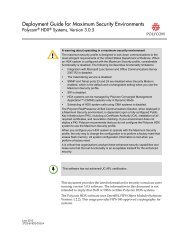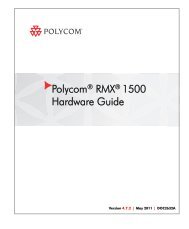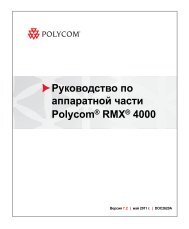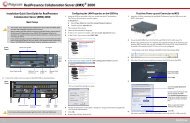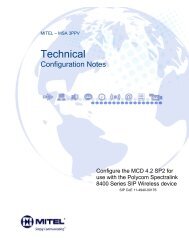RMX 4000 Quick Installation A3 V4.7.2.fm - Polycom
RMX 4000 Quick Installation A3 V4.7.2.fm - Polycom
RMX 4000 Quick Installation A3 V4.7.2.fm - Polycom
You also want an ePaper? Increase the reach of your titles
YUMPU automatically turns print PDFs into web optimized ePapers that Google loves.
<strong>Installation</strong> <strong>Quick</strong> Start Guide for <strong>RMX</strong> <strong>4000</strong><br />
Fabric Switch<br />
Module<br />
(FSM <strong>4000</strong>)<br />
Logo Panel &<br />
ESD Connector<br />
Signalling<br />
Network<br />
(Port 3)<br />
Management<br />
Network<br />
(Port 2)<br />
Off/On<br />
Switch<br />
Basic Setup<br />
Before installing the <strong>RMX</strong> <strong>4000</strong> and performing the Basic Setup, please read the<br />
General Safety Precautions described in the <strong>Polycom</strong> <strong>RMX</strong> <strong>4000</strong> Hardware Guide.<br />
For a detailed description of Unpacking and Rack mounting instructions, and<br />
connecting a DC system, see the <strong>Polycom</strong> <strong>RMX</strong> <strong>4000</strong> Hardware Guide.<br />
MPM+ Cards & LEDs Fan Drawer<br />
Power Supply Drawers<br />
and Status LEDs<br />
LAN Connections to Port 2 on each RTM LAN<br />
Power Cables<br />
<strong>RMX</strong> ® <strong>4000</strong><br />
Control Unit<br />
(CNTL <strong>4000</strong>) &<br />
LEDs<br />
Optional CPU<br />
(Future)<br />
Fan &<br />
Power<br />
Status<br />
LEDs<br />
Shelf<br />
Management<br />
(Port 6 on<br />
RTM IP)<br />
• Two people are required to lift the MCU out of the box and when installing it in a<br />
rack.<br />
• LAN 4, LAN 5 and the Serial ports are only for debugging and not for customer use.<br />
• Do not remove the protective plastic caps from LAN 1, LAN 4 and LAN 5 ports.<br />
Configuring the LAN Properties on the USB Key<br />
1 Insert the USB key provided with your system into the PC workstation.<br />
The <strong>Polycom</strong> Documentation window opens.<br />
In Windows XP:<br />
a The <strong>Polycom</strong> Documentation option is automatically selected. Click OK.<br />
In Windows 7:<br />
a Select Open Folder to view files using Windows Explorer.<br />
b Double-click the index.hta file.<br />
The Language Menu opens.<br />
2 Select the documentation language.<br />
3 In the License Agreement window, click the Accept Agreement button.<br />
4 In the Initial Setup Utility, click the <strong>RMX</strong> LAN Configuration Utility hyperlink.<br />
The LanConfigUtility dialog box opens.<br />
5 Modify the parameters in the utility’s dialog box using the information supplied by<br />
your network administrator.<br />
6 Click OK.<br />
7 Remove the USB key from the PC.<br />
First-time Power-up and Connection to MCU<br />
1 Insert the USB key containing the modified IP addresses in the USB port on the<br />
<strong>RMX</strong>’s back panel.<br />
2 Power the <strong>RMX</strong> ON.<br />
The parameters in the lan.cfg file are uploaded from the USB key to the <strong>RMX</strong>’s<br />
memory and applied during the power-up sequence.<br />
System power-up sequence may take up to five minutes.<br />
During the first-time power-up the red ERR LED on the <strong>RMX</strong>’s front panel remains<br />
ON until both the Management and IP Network Services have been defined.<br />
3<br />
4 Once the <strong>RMX</strong> Welcome screen is displayed, remove the USB key from the <strong>RMX</strong>.<br />
5<br />
Enter the IP address of the <strong>RMX</strong> Control Unit and press Enter.<br />
Enter POLYCOM.<br />
Enter POLYCOM.<br />
Click Login.<br />
Click to connect to <strong>Polycom</strong><br />
web site and register the <strong>RMX</strong>.<br />
Click Product Registration<br />
and follow the on screen<br />
instructions to obtain the<br />
Product Activation Key.<br />
Enter or paste the Product<br />
Activation Key obtained.<br />
Click OK.<br />
6 .<br />
1 DOC2628A
Modifying the Default IP Service<br />
This section describes the definition of H.323 Network Service. For detailed description<br />
of H.323, SIP and ISDN Network Service definitions, see the <strong>RMX</strong> Getting Started Guide,<br />
“First Time <strong>Installation</strong> and Configuration”.<br />
In the Fast Configuration Wizard, select Next to move from one window to another.<br />
1<br />
2<br />
3<br />
<strong>RMX</strong> ® <strong>4000</strong><br />
On the <strong>RMX</strong> <strong>4000</strong>, IPv4 is the default protocol for setting the Network Service in the<br />
Fast Configuration Wizard.<br />
Change the default service<br />
name if required.<br />
Enter the address to be<br />
used by IP endpoints when<br />
dialing in to the MCU.<br />
Enter the IP address(es) of<br />
the media card(s).<br />
Enter the subnet mask of<br />
the MCU.<br />
Enter the IP address of the<br />
default router.<br />
Enter the name of the MCU<br />
on the network.<br />
Optional. Select Specify to<br />
define a DNS server.<br />
Optional. Define the DNS<br />
server properties:<br />
• Registration mode<br />
• The name of the MCU<br />
domain<br />
• The static IP address of<br />
the primary DNS server<br />
4<br />
Select H.323 as the IP<br />
Network Type.<br />
Select Specify to configure<br />
the gatekeeper parameters.<br />
Enter gatekeeper’s host<br />
name or IP address.<br />
Enter the string with which the<br />
MCU registers itself with the<br />
gatekeeper.<br />
Enter the alias that identifies<br />
the <strong>RMX</strong>’s Signaling Host<br />
within the network. Up to five<br />
aliases can be defined for<br />
5<br />
each <strong>RMX</strong>.<br />
6 In the IP Network Service creation confirmation, click OK.<br />
Optional. Modify the default<br />
settings of the system flags<br />
that define the general<br />
system behavior such as the<br />
number of digits in the<br />
conference ID assigned by<br />
the MCU.<br />
These flags can be modified<br />
later, if required, by selecting<br />
the System Configuration<br />
option from the Setup menu.<br />
7<br />
8 Click Save & Close.<br />
9 In the Success Message box confirming successful configuration, click OK.<br />
10 In the Reset Confirmation dialog box, click Yes.<br />
11 In the Please wait for system reset message box, click OK.<br />
System restart may take up to five minutes.<br />
12 Refresh the browser periodically until the Login screen is displayed and Login.<br />
In the Main Screen an MCU State indicator displays the time remaining until the<br />
system start-up is complete.<br />
13 Create a new User with Administrator permissions and delete the default User<br />
(POLYCOM). For system security reasons, only when this step is completed and if<br />
there are no System Errors, the system is fully configured and the green RDY LED<br />
on the CNTL module (on the <strong>RMX</strong>’s front panel) turns ON.<br />
Connecting to a Conference Directly or via Entry<br />
Queue (EQ)<br />
The <strong>RMX</strong> is shipped with pre-configured default conferencing entities that can be used<br />
to dial in and start conferences. Default (Transit) Entry Queue ID: 1000,<br />
Default Meeting Room IDs: 1001, 1002, 1003, and 1004.<br />
Each conferencing entity uses the default Conference Profile called<br />
Event_Mode_720P_832Kb that has a default duration of one hour.<br />
H.323 Participants<br />
H.323 participants dial:<br />
[MCU Prefix in Gatekeeper][Conference or Entry Queue ID/Name]<br />
For example, if the MCU prefix in gatekeeper is 925, you can dial to the default (Transit)<br />
Entry Queue by entering 925 or 9251000 and be routed to Meeting Rooms by entering its<br />
ID (i.e. 1001, 1002, 1003 or 1004). You can connect directly to one of the default Meeting<br />
Rooms, by dialing its number, for example: 9251001.<br />
Alternatively, you can use the Entry Queue or conference name to connect directly to<br />
the conference. For example, if the conference name is Maple_Room, the participant can<br />
dial: 925Maple_Room.<br />
SIP Participants<br />
The dialing string is composed of the conference routing name as registered with the<br />
SIP server and domain name in the format: conference_name@domain_name<br />
For example, if conference routing name is 1001, the string is 1001@polycom.com.<br />
Conference Control Using DTMF Codes<br />
Operation DTMF String Operation DTMF String<br />
Mute My Line *6 Request individual<br />
assistance<br />
Unmute My Line #6 Request assistance for<br />
conference<br />
00<br />
Increase Broadcast Volume *9 Increase Listening Volume *76<br />
Decrease Broadcast Volume #9 Decrease Listening Volume #76<br />
Play Help Menu *83 Change To Chairperson *78<br />
Start Click&View to modify<br />
personal layout<br />
** Show Number of<br />
Participants<br />
*88<br />
Request to speak 99<br />
2 DOC2628A<br />
*0



